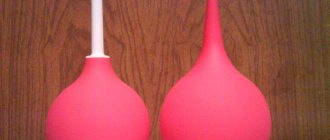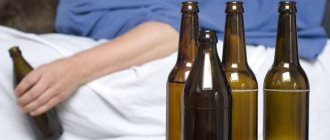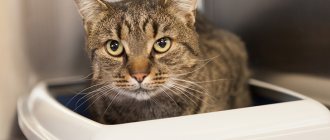develops in a bedridden patient quite often. Almost all patients in this category complain of problems with stool. In this case, intestinal function is restored mainly through medication, but diet also plays an important role. As for medications, laxatives for constipation for bedridden patients are prescribed exclusively by specialists, since not all of them are suitable for a sedentary lifestyle and can turn the disease into a chronic form.
So: caring for a bedridden patient: enema using a Janet syringe
So, first let’s determine how often should a patient who is bedridden have stool?
If the patient eats normally, then stool should be expected once every three to four days. But if he doesn’t eat, or is “on drips,” then stool once a week is good.
Why should you not use laxatives in paralyzed patients?
In very sick patients, especially after a stroke, laxatives can cause the most unexpected reactions - for example, severe nausea, violent peristalsis and vomiting. And if for an ordinary person these unpleasant reactions are not fatal, then in a paralyzed person vomiting can result in gastric contents entering the respiratory tract and aspiration pneumonia.
Therefore, I do not recommend laxatives for stroke patients.
How to improve bowel movements with diet?
We must try to establish regular bowel movements with the help of food. A bedridden person should be given yoghurt, oatmeal jelly, jelly with a decoction of plantain or flaxseed.
In what form should food be given to a paralyzed patient?
Let me remind you that patients after a stroke often have impaired swallowing and they cannot swallow LIQUID food and cope somewhat better with thick food. All food should have the consistency of thick sour cream. If the patient has impaired swallowing - dysphagia - you should not give food that contains small insoluble impurities (pieces of vegetables, fruits or minced meat)! Only cream and jelly! Read more: What to feed a bedridden patient
But such food leads to constipation, plus immobility is a direct road to intestinal obstruction.
That is why regular bowel movements are the number one issue!
How to give a large cleansing enema to a bedridden patient?
So, if the patient moves at least a little in bed, there is contact with him, and he can raise the pelvis and lie down on the bedpan, then he can be given a regular cleansing enema. See here how to give a cleansing enema to a bedridden patient.
Treatment of constipation after stroke
After a stroke, the patient experiences a disturbance in the passage of feces.
The main causes of constipation after a stroke:
- Damage to parts of the brain (lack of reflexes responsible for the urge to have a bowel movement).
- Hypodynamia (the patient is forced to constantly lie down, which contributes to the stagnation of chyme).
- Eating disorders (the patient has no swallowing reflex).
- Paralysis of the limbs (inability to take a comfortable position for defecation).
- Psychological aspects (patients are embarrassed to relieve themselves in front of relatives or strangers).
- Drug treatment (the use of certain drugs causes dysbiosis).
In a hospital setting, medications, a cleansing enema or digital stool extraction are prescribed to restore intestinal function.
Some patients after a stroke remain in the habit of taking laxatives at home, which has a detrimental effect on the regulation of independent urge to defecate.
Constipation after a stroke requires an integrated approach to treatment, which includes control over intestinal activity and diet correction.
Constipation after a stroke should be corrected with a plant-based diet.
It should include the following products:
- dill;
- beets;
- dried fruits;
- bran bread;
- lean types of meat;
- non-carbonated mineral water;
- fermented milk products.
To prevent difficult bowel movements, it is recommended to exclude the following foods:
- bakery products;
- yolk;
- canned meat;
- strong coffee, cocoa;
- bananas;
- pears;
- persimmon;
- potato;
- cabbage;
- carbonated drinks.
To enhance peristalsis in the patient, massage can be used. The procedure is performed several times a day; to do this, you need to place your hands on the patient’s stomach and perform massage movements clockwise. After the procedure, ask the patient to defecate on a special bedside vessel.
How to give an enema to a paralyzed person?
But it happens that the patient does not move, has poor contact with family, and does not understand how to behave during an unpleasant procedure. How should such a patient be given an enema?
And there is nothing simpler!
I will tell you how to do an unpleasant procedure so that the patient does not even understand that he was given an enema.
All unpleasant action will take place in PAMPERS - in disposable panties - diapers,
This is the great invention of our time - disposable diapers!
We will need diapers that absorb moisture well. I recommend disposable diapers for adults of the SENI brand - 7 drops or 8 drops.
- In addition, we will need a Janet syringe - 150 ml (such a syringe can be bought at a pharmacy) and
- The children's gas outlet tube is 20 cm long.
- Water for enema – 150 ml water temperature 37*C
- Rubber gloves or a plastic bag (otherwise you won’t have enough gloves)
- Vegetable oil (any kind, for lubricating the tube)
- Padded absorbent diaper.
- Waste bag
So, we put a 90x60 cm padding diaper on the bed.
Next, we put a diaper on the patient, but do not fasten it !
We insert an “insert” into the diaper directly under the perineum.
A “liner” can be made by cutting one diaper into three parts. We additionally place this one-third of the diaper inside the diaper under the “enema hole.” Dirty water and feces will leak onto this liner, so it must be placed well and deep into the sacrum.
Why is this liner needed if the diaper already absorbs moisture?
Believe me, it will be more convenient to collect the excreted stool, so as not to get dirty yourself and not to get the whole patient dirty.
Our bedridden man is ready for the sacrament!
Now we are preparing our “mini enema”
- We need to check whether it is possible to connect the Janet syringe and the gas outlet tube. If the nose of the syringe is too long and the tube “does not fit” on it, you can shorten the “nose” of the syringe - cut off the pointed part.
- After we have assembled the syringe and tube, we fill the syringe with water - 150 ml. Body temperature water.
- Lubricate the tube with oil.
- Letting out excess air from the syringe
- Now, with a gloved hand (or in a bag), gropes the patient’s anus - the “enema hole” and inserts the tube to a depth of 10 cm. Slowly without sudden movements.
- When the tube goes deep enough, slowly introduce all the water.
We take out the tube, fasten the diaper and leave our patient alone.
After 20 minutes you can check the result.
If the patient has emptied, then all the dirty water and feces will be on the liner, which we remove and throw into a waste bag. Now you don’t have to be afraid of getting dirty and you can wash the calm patient and change him into a clean diaper.
Factors that cause constipation
Constipation occurs due to poor intestinal motility, which can be caused by various factors. Physical inactivity, poor microcirculation in tissues and decreased metabolism lead to decreased motility of the gastrointestinal tract (GIT).
Additional causes of constipation:
- intestinal diseases;
- drug intoxication;
- poor nutrition;
- lack of fluid in the body.
Note. Frequent use of laxatives leads to habituation of the intestines and inhibits the natural process of peristalsis.
Reasons for rejection
Due to changes occurring in the body, older people often suffer from constipation. The reasons may be different, in most cases they are associated with age-related changes in the body.
Possible causes of constipation in older people:
- physiological - weakening of muscle tissue in the pelvic and abdominal areas and “drying out” of intestinal peristalsis complicates the process of defecation;
- changes in the intestinal environment - intestinal bacterial microflora loses its beneficial properties;
- unhealthy diet – eating foods that cause the formation of hard feces;
- frequent use of medications;
- accompanying illnesses.
Coping with constipation in old age can be very difficult, especially for bedridden patients.
Stool retention in the elderly may be due to a violation of the intestinal microflora, in which there are fewer beneficial bacteria
If measures are not taken in a timely manner, fecal stones form, which cause fecal obstruction.
Consequences of constipation
Decreased physical activity leads to problems with bowel movements. Constipation may occur after just 2 weeks of bed rest. The problem is especially relevant for the body of an elderly person. The pathology is aggravated by the psycho-emotional state. Ashamed of natural bowel movements, the patient tries to keep feces inside for as long as possible. When they accumulate, they disrupt intestinal tone and provoke intoxication of the body.
Complications of constipation cause the following conditions in bedridden patients:
- disruption of the gastrointestinal tract;
- development of paraproctitis and hemorrhoids;
- intoxication and irritation of the intestinal mucosa;
- spread of infection;
- enteritis;
- oncological neoplasms.
The immune system of a bedridden person is weakened, so you need to know how to give an enema to a bedridden patient and empty the intestines in a timely manner, preventing the development of complications.
How much does an at-home enema cost?
The cost of performing an enema at home does not include additional ground travel for the nurse. The client pays an additional 100 rubles. in case the walk to his house is more than 15 minutes from the metro.
| Service | price, rub. |
| regular enema | 1500 |
In all these cases, the services of a nurse are required to administer an enema at home. Calling a nurse to your home to perform a paid enema will help you quickly and competently deal with what the patient or his loved ones cannot do on their own.
Prolonged bed rest can cause a person to have problems with bowel movements. If the patient cannot empty his bowels for several days, his relatives should know how to give an enema to a bedridden patient at home. The task of loved ones is to alleviate the person’s condition as much as possible and normalize daily bowel movements.
Colon cleansing procedures
An enema for a bedridden patient is used not only as a cleansing procedure. For intestinal diseases, it is recommended to administer rectal medicinal formulations at home. They help to gently relieve inflammatory processes, restore microflora and improve blood circulation in the pelvic organs.
To carry out the procedure correctly, you need to study as much information as possible on how to give an enema to a bedridden patient at home. Depending on the desired effect, various means of manipulation are used.
Using Esmarch's mug
The classic method of a cleansing enema is using an Esmarch mug. The device is freely available at any pharmacy. The product consists of an enamel or plastic reservoir (mug) or a rubber bulb (like a heating pad) and a discharge tube built into them. The length of the hose in different models can reach 2 meters. A tip is attached to the opposite end of the tube for insertion into the anus. The volume of the mug varies from 1 to 3 liters. Modern devices have a faucet or clamp. The product is intended for repeated use.
Advantages of Esmarch's mug:
- ease of use;
- suitable for the use of various medicinal solutions;
- effectively removes slagging from the rectum;
- allows you to adjust the volume of injected liquid;
- can be used repeatedly;
- low cost.
During cleansing enemas for bedridden patients, the contents of the mug are filled with warm boiled water at room temperature or with specially prepared solutions based on herbal decoctions.
The table describes step by step how to give an enema to a bedridden patient at home.
| Stages of the procedure | Process description |
| Preparing for an enema |
|
| Processprocedures |
|
| Final stage |
|
How to do an enema at home according to Neumyvakin with hydrogen peroxide?
Enema according to Neumyvakin is carried out using a system for placing droppers.
- First you need to heat the solution to 36˚. You can put it under a stream of warm water.
- Insert the lubricated tip into the rear hole, lying on your left side.
- Using the wheel on the system, adjust the solution flow rate, which should not exceed 60 drops in 1 minute.
Sodium peroxide enema can be given every other day. The course of treatment procedures consists of 10 enemas. If necessary, can be repeated after 45-60 days.
After introducing peroxide into the intestines, the temperature may rise, you may feel weak and vomit. This occurs due to the fact that parasites die in the body. At this point, it is recommended to drink water with a little salt or apple juice.
Contraindications
Not all categories of bedridden patients can be given an enema. There are cases when this procedure is contraindicated. It is forbidden to forcefully cleanse the intestines under the following conditions:
- open wounds in the abdominal cavity;
- the presence of hernias in the groin;
- the presence of hemorrhoids in the acute stage;
- pregnancy;
- malignant intestinal tumors.
It is not recommended to use cleansing procedures more than 2-3 times a month. It is necessary to eat properly and drink enough fluids. This way you can avoid the accumulation of feces. Knowing how to give an enema to a bedridden patient at home, loved ones can alleviate his condition and improve his quality of life.
Video
091
Bed rest, which continues for quite a long time, brings many problems to the patient. First of all, intestinal function is disrupted. This often forces one to give an enema to a bedridden patient - it can serve several purposes. The main one is cleansing, which helps the patient empty his intestines.
Problems with stool have become a real problem for bedridden patients. Constipation has an extremely negative effect on a person’s general condition, and they need to be dealt with in a timely manner. An enema is a simple and effective remedy for bowel movements during constipation. Before giving an enema to a bedridden patient, you need to find out the cause of constipation.
Laxatives for constipation
To alleviate the condition, the doctor may prescribe laxatives. For these purposes, bistro-acting drugs are used; they help to empty the intestines for 2-10 hours.
Laxatives used in bedridden patients:
- Plant-based preparations (Senade, Fybefrom, Depuraflux).
- Irritants (Guttalx, Regulax, Pirilax).
- Saline laxatives (magnesium sulfate, Carlsbad salt, sodium salt).
- Prebiotics (Duphalac, Linex, Bifidumbacterin).
It is recommended to use laxatives at night to allow bowel movements to occur in the morning.
In patients on bed rest, constipation can be treated with a lactulose-based drug. It has a stimulating effect on intestinal motility and is used to prevent diseases of the digestive system.
Lactulose is used to treat chronic stool retention and dysbiosis, and helps restore beneficial intestinal microflora. The mechanism of action is based on the ability of the drug to retain fluid in the colon.
Indications for an enema
The main indication for this procedure is prolonged constipation. We can talk about it if bowel movements do not occur for more than 3 days. But the list of indications is much wider:
- flatulence, constant belching or heartburn;
- intoxication due to various types of poisoning;
- cleansing before diagnostic measures (ultrasound, x-ray);
- inability to empty the intestines due to addiction to laxatives.
Carrying out this manipulation allows you to avoid many complications of constipation. Among the main ones are paraproctitis, hemorrhoids, and enteritis. Constipation often causes cancer in the intestines. An enema for a bedridden patient at home helps prevent these complications - the main thing is to follow the correct technique for performing it.
Other methods
If the patient's condition allows, it is necessary to do gymnastics for the anterior wall of the abdomen. All exercises are performed in a supine position. Having bent your knees, you need to pull them as close as possible to your stomach, fixing them in this position for a few seconds, and then slowly straighten them. Next, you should inflate your stomach as much as possible and hold it in this position for several seconds. The last exercise is maximum abdominal retraction followed by a delay of several seconds. You need to do such gymnastics every day, even if there is no constipation - for preventive purposes.
If changing your diet and doing exercises do not help, you can use a cleansing enema. The water must be purified using a filter, boiled, and at room temperature. You cannot add oil or other substances to an enema without a doctor’s prescription. Self-use of laxatives is also unacceptable.
Enemas can be given at intervals of at least two weeks. This procedure is contraindicated for abdominal pain and fever.
Constipation in the elderly, the treatment of which must be complex, often worries patients over 50 years of age. According to statistics, every second elderly person suffers from defecation disorders. Moreover, in older women, constipation occurs more often than in men. This condition is quite dangerous, as it causes intoxication of the body, decreased immunity and general depression. How to deal with constipation in older people?
Defecation is considered normal, which occurs from 2-3 times during the day to 3 times during the week. If bowel movements do not occur for more than 2 days in a row, then this can be called constipation.
Other signs of constipation in older adults include:
- incomplete bowel movement;
- slight excretion of feces;
- stool that causes pain and passes with difficulty;
- feces have a dense consistency;
- retention of feces when straining;
- the need to press on the pelvic area or perform other manipulations to facilitate the process of defecation.
Disruption of the process of defecation in old age has its own classification.
There are the following types of constipation in older people:
- Chronic. It occurs most often and requires a comprehensive examination, which will help to understand the cause of the condition and choose the right treatment.
- Constipation in a bedridden elderly patient. The main reasons for prolonged defecation in bedridden patients are the lack of physical activity and the need to take various potent medications. A balanced diet and physical activity can help correct the situation.
- Long-term constipation. A variety of reasons can lead to this condition: from nutritional disorders to serious health problems. To get rid of constipation, a person needs to undergo a comprehensive examination to determine the specific cause of the condition.
- Persistent constipation in older people is considered the most dangerous type of constipation, as it leads to chronic intoxication of the entire body. The reason is usually a change in the functioning of some internal organs. Treatment in this case should be complex and long-term.
- Severe constipation in older people is manifested by pain, heaviness in the abdomen, loss of appetite and other unpleasant symptoms. To get rid of this condition, the patient usually just needs to change his lifestyle.
With age, various changes occur in the human body. One of them is inhibition of motor activity of the digestive tract. And this, in turn, provokes a delay in the movement and removal of feces. In addition, the sphincter loses its sensitivity over time, and the urge to defecate in a person becomes less pronounced.
In addition, there are other causes of constipation in older people:
- Violation of the drinking regime and reduction in the amount of fluid consumed.
- Nutritional disorders (deficiency of dietary fiber in food).
- Taking various medications.
- Decreased physical activity.
But there are cases when constipation in an elderly person becomes a consequence of various diseases, including:
- diabetes;
- hypothyroidism;
- multiple sclerosis;
- chronic diseases of the gastrointestinal tract (pancreatitis, ulcers, duodenitis, etc.);
- atherosclerosis;
- inflammatory processes in the pelvic area;
- Parkinson's disease;
- depressive state.
Before starting to treat senile constipation, the doctor will prescribe the patient a comprehensive examination that will help determine the specific cause of the disorder.
To do this you will need:
- Take a stool test to determine microflora.
- Blood test to determine sugar and hormone levels.
- Perform a histological analysis of biopsy samples of the intestinal mucosa.
- X-ray examination.
- If necessary, the doctor will prescribe an instrumental examination (colonoscopy, irrigoscopy).
Only after a detailed examination will the doctor be able to prescribe treatment for constipation in older people.
Treatment of constipation in older people should be carried out comprehensively, based on the results of the examination and taking into account the reasons that caused constipation. For this, drug therapy, folk remedies, local medications (suppositories), enemas, diet, etc. are used.
Use of folk remedies
Often, if defecation disorder is not associated with various diseases, then folk remedies can be used to eliminate it:
- It is recommended to regularly add bran to food (2 tablespoons).
- Flaxseed, from which a decoction is made, effectively combats the absence of bowel movements.
- Drinking a glass of kefir with the addition of 1 tablespoon of vegetable oil before bed helps to get rid of constipation.
- Between meals, it is recommended to drink 50 ml of elderberry leaf infusion. To prepare it, you need to pour 20 g of dry raw materials with 1 cup of boiling water and leave until it cools completely.
- An infusion made from a mixture of anise and buckthorn bark, taken in a ratio of 1 to 4, has a good effect. 1 tablespoon of this mixture is poured into a glass of boiling water and left for 30-60 minutes, then filtered and drunk before bed.
- You can make a decoction of sweet clover and nettle, taken in equal proportions. 1 tablespoon of dried plants is poured with a glass of boiling water and kept in a steam bath for 15-20 minutes. After cooling, strain the broth and drink 1 glass before breakfast and dinner.
Treating constipation in older adults sometimes requires taking laxatives. For this they are prescribed:
- Drugs that can stimulate intestinal motility (Regulax, Bisacodyl).
- Medicines that increase osmotic pressure in the intestines (Forlax, Duphalac, Magnesium sulfate, Inulin).
- Dietary fiber (Mukofalk).
If an elderly person experiences severe pain in the abdomen, they need immediate medical attention, as this may be a manifestation of intestinal obstruction.
This condition is very dangerous and requires urgent surgical intervention.
Prescribing enemas
If in old age constipation appears periodically and is not associated with intestinal diseases, then the doctor may prescribe:
- Suppositories and microenemas (Bisacodyl, Peidolax).
- Microclysters with glycerin, almond or vaseline oils.
Diet and principles of proper nutrition
Additionally, patients are recommended to consume dietary fiber (30 g per day with food is sufficient). A glass of cold water drunk on an empty stomach will help stimulate peristalsis. In this way, even long-term constipation can be overcome.
Massage and gymnastics
To get rid of constipation, which often occurs in older people, they need to move. Daily walks in the fresh air and exercises that help strengthen your abs will be effective.
In the morning you can perform self-massage. To do this, immediately after waking up, you need to lightly massage your stomach in a clockwise direction. This procedure will be especially relevant for constipation in elderly bedridden patients, the fight against which becomes a real challenge for such people due to the inability to move normally.
Contraindications for an enema
Not in every case an enema for bedridden patients at home can be beneficial. This procedure has several serious contraindications. The main ones include:
- bleeding from the anus of any etiology;
- inflammatory diseases of the rectum;
- tumors in the intestines;
- pain syndrome in the abdomen.
The best option would be to prescribe an enema by a doctor - he will be able to correctly assess the existing contraindications and choose the type of enema.
What are the benefits of an enema?
From ancient times until the beginning of the twentieth century, enema was considered almost a panacea for all diseases. However, progress has also affected the sphere of medical services, displacing the administration of an enema to a less respectable place. Despite such injustice, the procedure has not lost its legitimate benefits, and therefore is carried out, albeit less frequently, to this day.
- The same constipation , which, unfortunately, is very typical for elderly and pregnant people, as well as for those who are addicted to completely unhealthy diets, can most easily be solved with the help of an enema.
- Intestinal diseases , contrary to modern opinion, can also be cured with an enema.
- Moreover, many females, in pursuit of beauty, use this method of cleansing the body, even without having a direct need for it.
Main types of enemas
View
| Destination purpose | Mechanism of action | Indications | |
| Cleansing | Diagnostic or therapeutic | Softening stool and enhancing peristalsis | Prescribed for the treatment of constipation, before diagnostic measures, before administering medicinal enemas. |
| Oil laxative | Medical | Facilitating the elimination of feces | Ineffectiveness of a standard cleansing enema |
| Laxative with hypertonic solution | Medical | Marked increase in peristalsis and causing loose stools | Massive swelling and failure of other measures to treat constipation |
| Medicinal | Medical | Reduces irritation in the intestines, eliminates spasms | Administration of medications when other administration options are not possible |
Stages of the procedure at home
Giving an enema to a bedridden patient requires some experience. In addition, the correct psychological preparation of the person himself is also necessary. If such a procedure is to be carried out, the person needs to have the process and purpose explained in advance. It is worth explaining about possible unpleasant sensations and that they are all temporary. A cleansing enema for a bedridden patient is carried out in comfortable conditions for him - this will reduce psychological tension and increase the effectiveness of the entire procedure. For convenience, you can break it down into several stages.
Preparation
If constipation is diagnosed, then a cleansing enema is prescribed to the bedridden patient. To carry it out, an Esmarch mug is used. It consists of a rubber reservoir with a long tube to which a plastic tip is attached. To carry out the procedure safely, you will need to boil and cool about one and a half liters of water. This amount is sufficient in most cases.
The mug must be clean - you can pre-treat it with a solution of hydrogen peroxide. The tip that will be inserted into the rectum must first be boiled. For painless administration you will need Vaseline or any vegetable oil. The patient is placed on his side, the lower part of the body is exposed.
Progress
Water at room temperature is poured into Esmarch's mug - its tap must be closed. The tip is generously lubricated with Vaseline or oil. Its insertion into the anus should be carried out smoothly, preferably with rotating movements. The insertion depth should not exceed 8-10 cm. After inserting the tip, a tube is carefully attached to it, and the tap of Esmarch’s mug opens.
Attention! During the administration of water, patients often experience pain. In this case, the water pressure needs to be reduced - lower the mug, or close the tap.
After introducing the entire volume of water, you will need to massage the person’s stomach. this is done with smooth circular movements, avoiding strong pressure. During the massage, the injected liquid will be evenly distributed throughout all parts of the intestine. This will most effectively stimulate peristalsis and cause the passage of feces.
Completing the procedure
15 minutes after the administration of the fluid, the patient should be placed on his back. In most cases, defecation occurs on its own - you must first place a duck under the person. But sometimes defecation is not so easy to achieve - for example, in the case of severe intestinal atony. In this case, it will be necessary to stimulate the passage of feces.
The easiest way was the “bicycle” exercise. If the patient cannot do it himself, outside help will be required. You need to move quite carefully, with average intensity. In most cases, this is quite enough for defecation to occur.
Oil enema
It is not always the case that a standard cleansing enema for a bedridden patient will facilitate the excretion of feces. In addition, the question of how often you can give an enema to a bedridden patient is also important. There are no strict restrictions here. But it is undesirable to do this too often; moreover, in some cases, an oil enema becomes the most preferable.
The oil introduced into the intestines coats the stool very well. This promotes their gentle and complete removal from the intestines naturally. You can use any oil for the procedure - there are no restrictions. But it is much more useful to give an enema at home to a bedridden patient using sea buckthorn oil. In addition to the standard laxative effect of the procedure, the oil will have an anti-inflammatory effect on the intestinal walls.
To give an enema to a bedridden patient at home using oil, you will need a syringe. Its volume varies, but it is undesirable to use too much oil - 50-100 ml is enough for one procedure, and such an enema for a bedridden patient with severe constipation will help much better than a cleansing one. The procedure is simple:
- the syringe is filled with oil - it should be at room temperature;
- the tip of the syringe is lubricated with Vaseline and inserted into the rectum;
- the entire volume of oil is introduced into the intestines;
- the syringe is carefully removed, the patient turns over on his back.
When determining how to give an enema and which one to a bedridden patient, you need to use common sense. If constipation occurs for the first time, you can completely limit yourself to a simple cleansing procedure. Prolonged and persistent constipation requires a different approach. In addition to quite effective and safe oil, there are also medicinal ones.
They are laxatives that are administered directly into the intestines - they are effective and safe. For example, the drug Microlax. It causes an increase in water content in the intestines. This leads to an increase in the volume of feces, stimulation of peristalsis and soft bowel movements. The administration of the drug does not cause any difficulties.
Proper nutrition
Food should be easily digestible, but solid. Hot food is a must in your diet.
If we are not talking about heart or kidney disease, the patient needs to drink as much as possible.
It is necessary to exclude from the patient’s diet foods that have a strengthening effect: eggs, rice, walnuts, blueberries, pomegranate juice, strong tea. Potato consumption should be limited.
Normal intestinal function is promoted by cereal porridges and vegetable salads with sunflower oil, as well as foods rich in fiber: buckwheat, cabbage, beets, black bread, wheat bran.
Apricots, prunes, dates, raisins, and carrot juice have a laxative effect.
If constipation is caused by a violation of the intestinal microflora, biokefir and other fermented milk products will help restore it.











